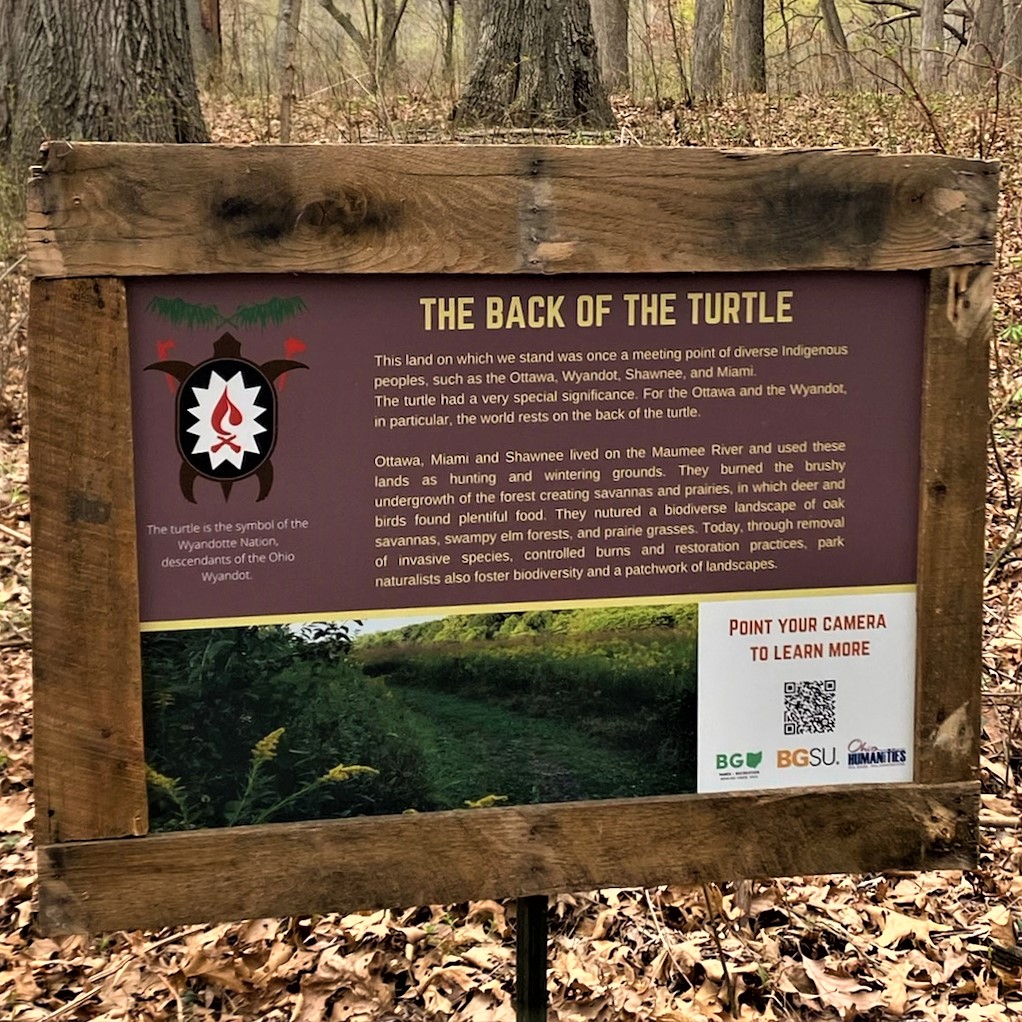
Did you know that Indigenous peoples call this land “Turtle Island”? The turtle is seen as a symbol of creation for many Indigenous peoples, especially the Wyandot. The sign “The Back of the Turtle” explores the creation story of the Wyandot people and the symbolism of the turtle. The sign’s title comes from both the award-winning Cherokee author Thomas King’s novel The Back of the Turtle, and Lloyd Devine’s On the Back of the Turtle; A Narrative of the Huron-Wyandot People. In multiple creation stories of North American indigenous groups (including those of the Wyandot and Ottawa), the turtle signifies the earth, particularly, the North American continent, that sustains all life as we know it.. Indigenous peoples often refer to the land as “Turtle Island” as a way to express the resilience of native cultures and practices despite centuries of colonial rule and relocation policies.
For the Wyandot, and many other Indigenous Nations, stories like “Big Turtle” hold a lot of cultural and religious significance. These stories are only told in the winter around the village elders, so they are a special occurrence and only hold their true meaning when listened to properly.
In the Wyandot’s creation story, the earth existed in two separate parts. The Wyandot lived in the sky and the animals lived below them in a vast body of water. One day the daughter of the Wyandot’s chief fell from their home in the sky into the water below and was saved by the animals. There was no land for the girl to live on, so the animals built her an island on the back of the Great Turtle, which would come to be the earth that we live on today.
To learn more
To learn more about the Wyandot, their history and culture:
- Divine, Lloyd E. On the Back of a Turtle: A Narrative of the Huron-Wyandot People, 2019.
- Barbeau, Marius. Huron and Wyandot Mythology, with an Appendix Containing Earlier Published Records. Ottawa, Government Printing Bureau, 1915. http://archive.org/details/huronwyandotmyth00barb.
The strong symbology of the turtle for different native groups that lived around the Great Black Swamp serves also as a metaphor of the swamp as a cross-cultural cross-roads of Algonquin- and Iroquois-speaking peoples. To learn more about the multiethnic Native American societies that lived around the Great Black Swamp, we recommend the following readings:
Brooks, Michael. “The Potawatomi, Europeans, and the Great Black Swamp: An Examination of Nisnabek-Newcomer Interactions in Northwest Ohio.” Northwest Ohio History. 85.1.
Stockwell, Mary. The Other Trail of Tears: The Removal of the Ohio Indians. First Westholme Paperback 2016. Yardley, Pennsylvania: Westholme Publishing, LLC, 2016.
Tanner, HH. “The Glaize in 1792: A Composite Indian Community.” Ethnohistory. 25.1. (Winter, 1978), pp. 15-39. Duke University Press. URL: https://www.jstor.org/stable/481163
Photo Credits
- Wyandotte Nation, Wyandotte Nation Turtle, https://www.wyandotte-nation.org/culture/about-our-turtle/.The permission (via email) is given by Chief Billy Friend.
- Mohammad Mizanur Rahman, Photo of Wintergarden, photograph (Wintergarden/St. Johns Nature Preserve , September 11, 2019).
Text, Research, and content created by Mohammad Mizanur Rahman, PhD Student in School of Cultural and Critical Studies. Text, research and content created by Keith Lenhart, M.A. student in History. Edited by Dr. Amílcar Challú, Associate Professor of History, Bowling Green State University, and Carolyn Dailey, history senior.

